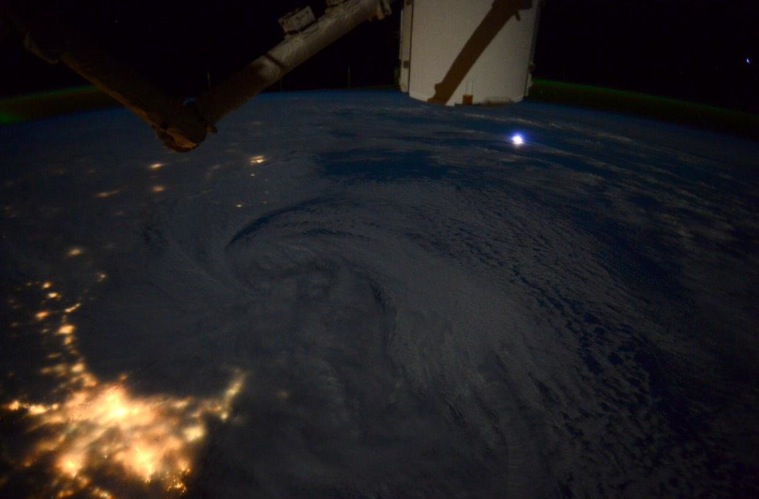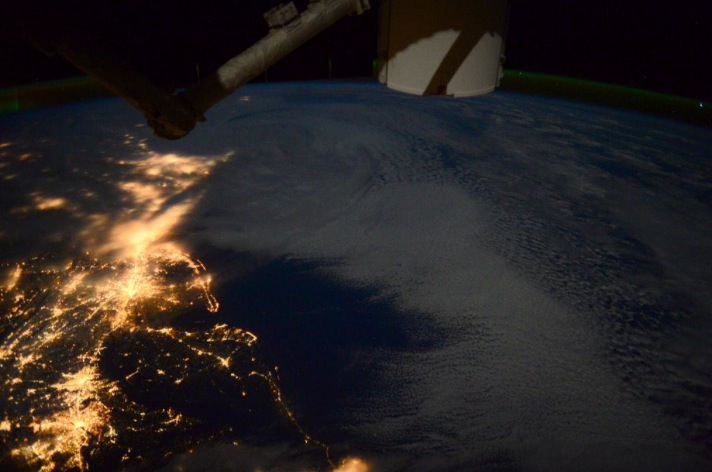Astronaut Sees Huge Winter Storm from Space (Photos)

The monster winter storm that dumped loads of snow on the northeastern United States on Monday and Tuesday (Jan. 26 and 27) looked pretty beastly from 250 miles (400 kilometers) above the planet.
NASA astronaut Terry Virts, a member of the current Expedition 42 crew aboard the International Space Station, captured several dramatic photos of the storm Tuesday night, as it wheeled and churned over New England.
The blizzard "looks like a hurricane — last night she was just east of #Boston," Virts tweeted about one image, which also features what looks to be a flash of lightning northeast of the storm.
Robotic eyes have also been keeping tabs on the winter storm, from much higher altitudes. For example, the Suomi National Polar-orbiting Partnership satellite, which is operated jointly by NASA and the National Oceanic and Atmospheric Administration (NOAA), looked on as the storm hammered the Northeast early Tuesday morning, when it was near peak intensity.
"The nighttime lights of the region were blurred by the high cloud tops associated with the most intense parts of the storm," NASA officials wrote about the satellite image.
Other images of the winter storm — which is known as a nor'easter, because its winds are blowing primarily from the northeast — have come courtesy of NOAA's GOES-East satellite.
GOES-East (short for Geostationary Operational Environmental Satellite) captures infrared and visible-light cloud data, which is then overlain on views of land and sea taken by NASA's Aqua and Terra Earth-observing satellites.
Breaking space news, the latest updates on rocket launches, skywatching events and more!
The winter storm, which meteorologists have been calling Juno, dumped up to 3 feet (0.9 meters) of snow on some parts of New England over the past few days. It is now petering out, but the U.S. National Weather Service says the Northeast will likely get another round of snowfall Thursday and Friday (Jan. 29-30).
Indeed, parts of the planet look like a winter wonderland from orbit at the moment.
"In these winter time[s], sometimes it feels like the whole world is shrouded in cloud! #HelloEarth," Virts' Expedition 42 colleague, European Space Agency astronaut Sam Cristoforetti, posted on Twitter early Wednesday (Jan. 28), along with a stunning photo of the planet.
Follow Mike Wall on Twitter @michaeldwall and Google+. Follow us @Spacedotcom, Facebook or Google+. Originally published on Space.com.

Michael Wall is a Senior Space Writer with Space.com and joined the team in 2010. He primarily covers exoplanets, spaceflight and military space, but has been known to dabble in the space art beat. His book about the search for alien life, "Out There," was published on Nov. 13, 2018. Before becoming a science writer, Michael worked as a herpetologist and wildlife biologist. He has a Ph.D. in evolutionary biology from the University of Sydney, Australia, a bachelor's degree from the University of Arizona, and a graduate certificate in science writing from the University of California, Santa Cruz. To find out what his latest project is, you can follow Michael on Twitter.



